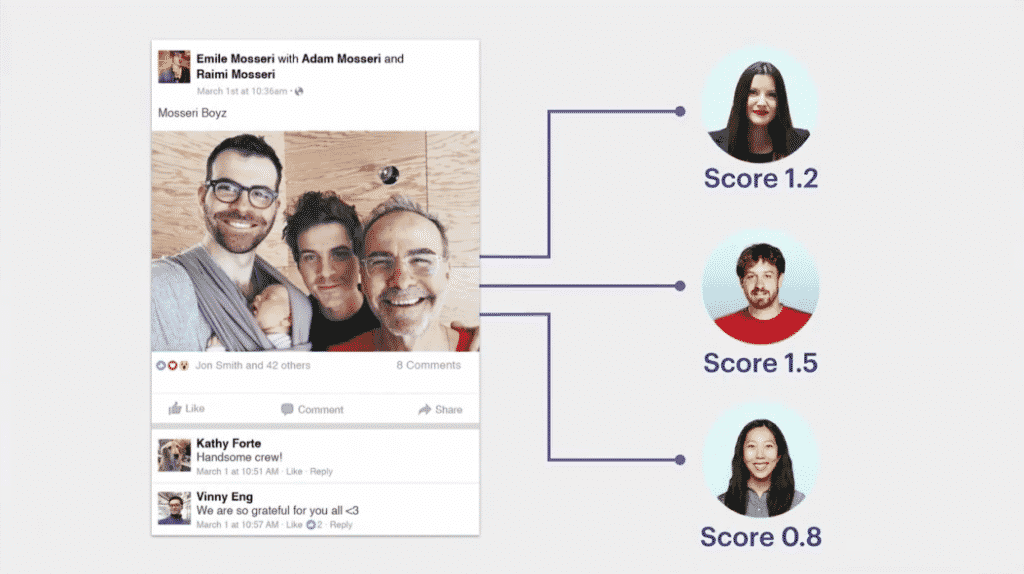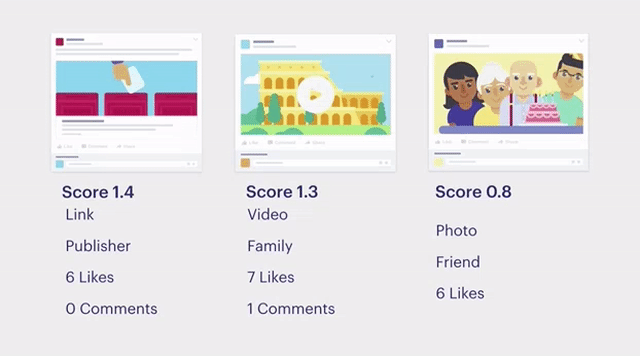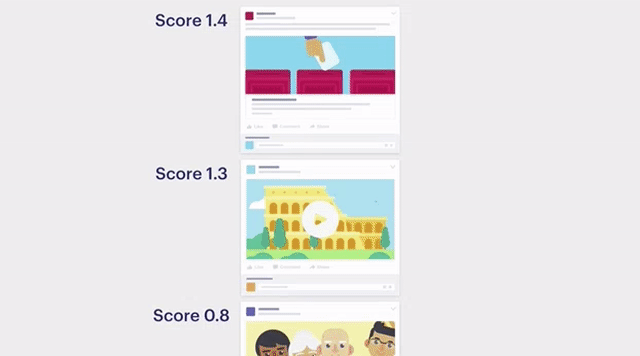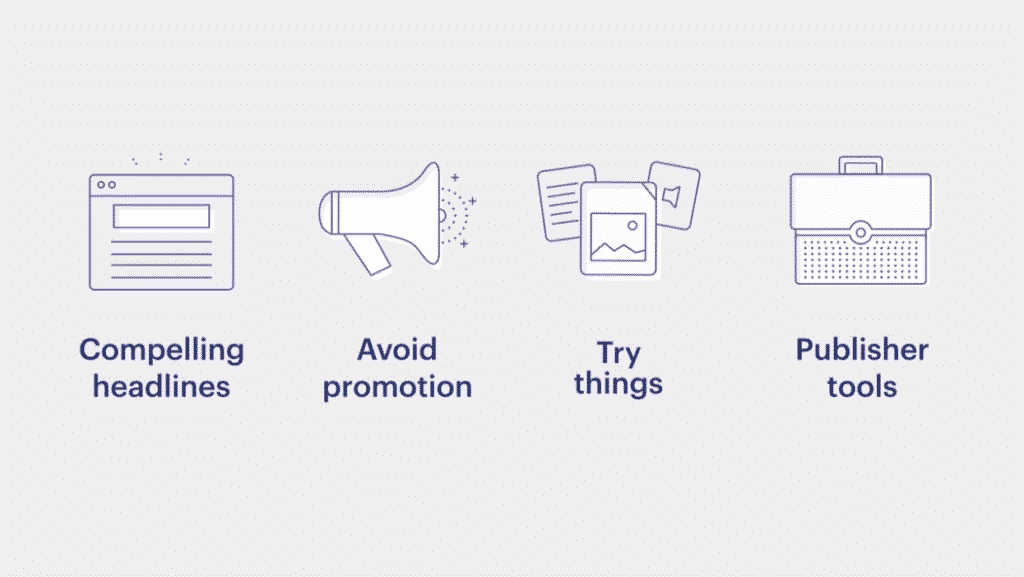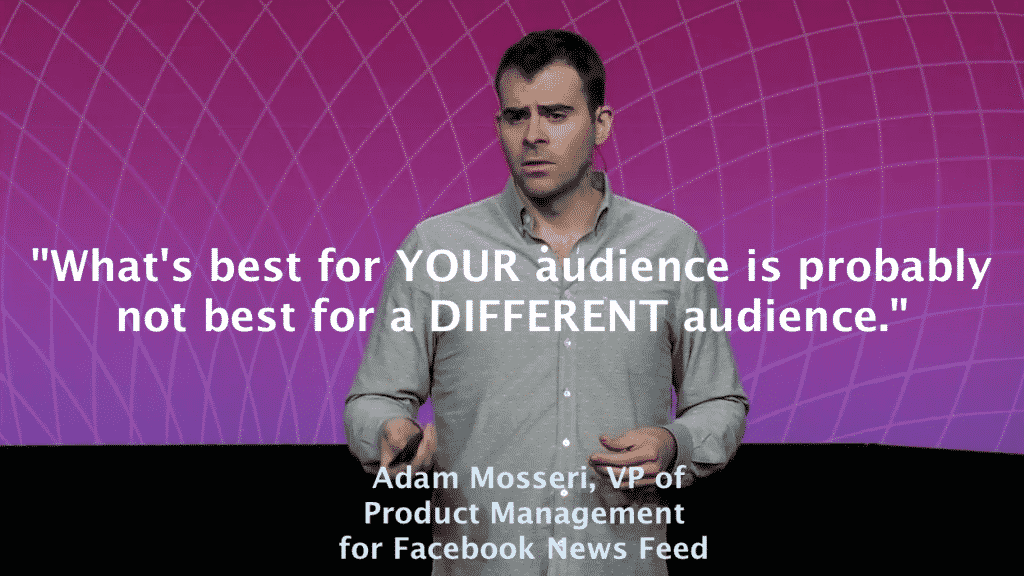Updated 2019 – Since we originally published this article, Facebook has made many changes. We have updated the original post to reflect Facebook’s algorithm changes.
Ever wonder what a Facebook algorithm actually looks like in action?
No matter how much you hear about the things Facebook wants you to do – and doesn’t want you to do – actually understanding how all those rules and guidelines come together in an algorithm can be tricky.
Fortunately, seeing the exact process Facebook uses to determine the reach of your posts just got a lot easier. At their F8 developer conference in April, Adam Mosseri – their VP of Product Management for News Feed – gave a presentation demystifying just how Facebook qualifies posts on a user-by-user basis.
If you want to know exactly what a Facebook algorithm looks like, this is it.
What are the factors that determine a post’s placement in the News Feed? How does Facebook make those decisions? And what are the four things this Facebook exec recommends everyone do more of?
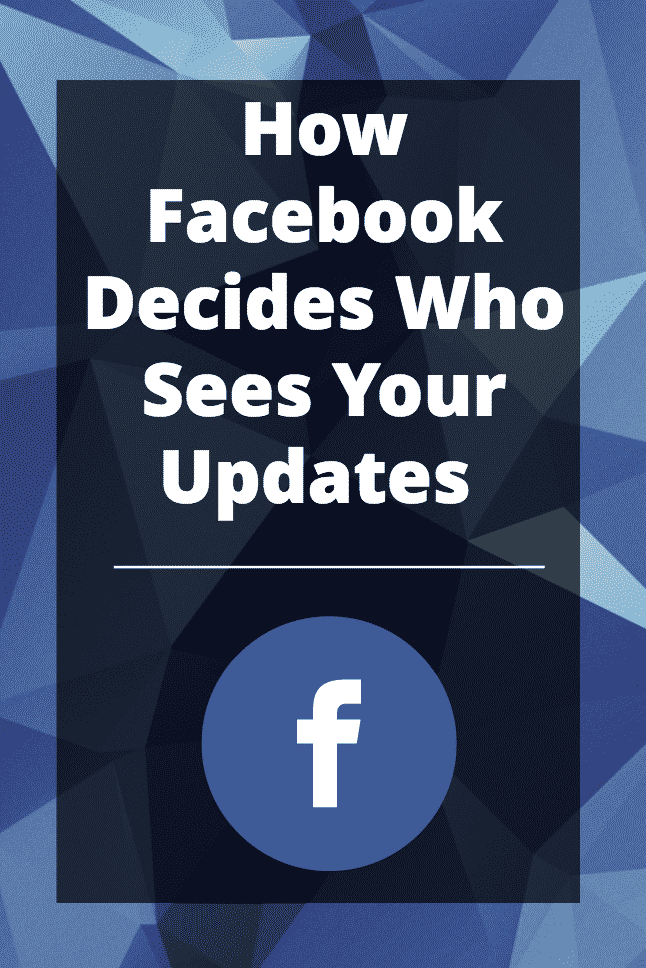
Get a look at everything you need to know in this recap:
The Four Base Factors That Determine a Post’s Audience
There are a LOT of granular little factors that influence Facebook reach.
Some of them are specific to the type of page you are.
Some of them have to do with specific posting trends Facebook wants to encourage – or discourage.
Ultimately, though, it always comes down to variations on four main aspects to every single post.
Facebook wants every user to see the posts that will be most interesting to them, whether those posts are shared by friends, family, brands, or legendary recording artist and pride of Quebec, Celine Dion.
How does Facebook predict what a user will find interesting? By analyzing these four things:
- Who posted the update
True story: You’re more interesting to some people than others.
It’s nothing personal – you probably post really valuable stuff! (Honest.) But the fact is, you’re just more relevant to some people, and those are the people Facebook wants to see your updates.
Think of this as the “Your mom” principle. (Not to be confused with the “your mama” principle, which has fueled many a schoolyard feud.)
If you have one of those moms who always wants to know what you’re up to, then she’s gonna love seeing every single one of your posts, right? Probably more so than, say, your coworker’s nephew’s roommate’s field hockey coach, who you friended by accident.

Basically, the more into you somebody is, the more they’re gonna see the things you share. The less they care about what you share, the less they’re gonna see it.
(How exactly does Facebook determine whether or not someone cares about what you’re posting? Read on – we’ll explain in a minute!)
- What type of update is it
Different people prefer different types of content in the News Feed.
Maybe you like it when people share photos, or maybe you never met a link that you could resist clicking.
Facebook pays attention to your behavior, and factors it in when it’s deciding what types of post to show you. It wants you to like what you see, so it’s going to show you what it knows you like.
- How much engagement does the update have
No surprise here – engagement rate matters. Facebook has been saying it for years, and it’s still as true as ever.
When a post is getting activity like comments, likes, clicks, and shares, Facebook assumes that it’s interesting to the people who see it – and it may start getting better reach.
The way that Facebook evaluates different types of engagement has evolved over the years (especially with the addition of features like live video and reactions), but at its most basic level, one thing has never changed – quality activity on your posts is a huge advantage.
- When was the update posted
Recency matters on Facebook – but it isn’t the only thing that matters.
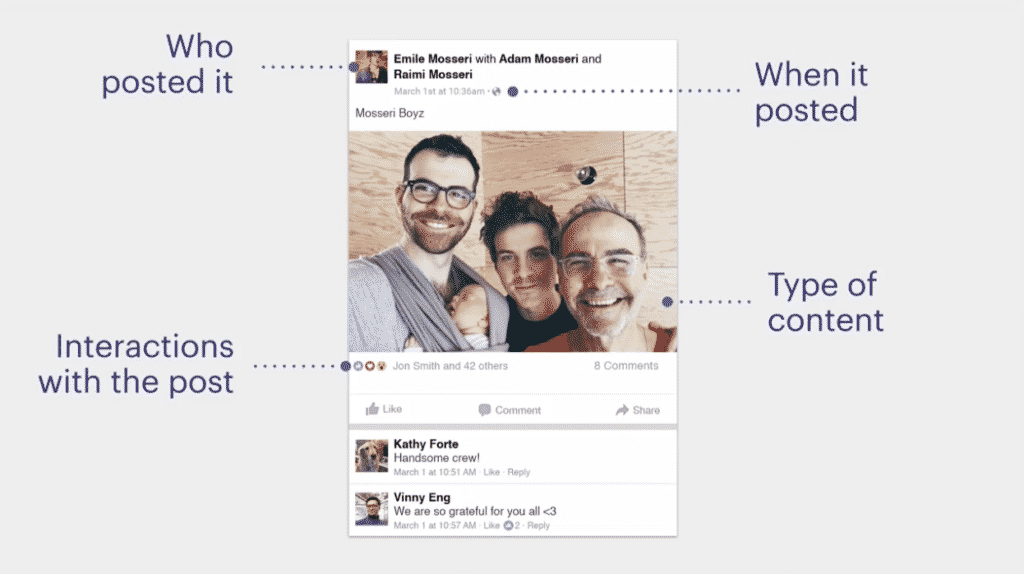
Facebook doesn’t want you to miss something that might be important to you just because you haven’t logged on lately, so even though it values newer updates, it also considers that something older might be relevant.
(It’s the same reason Twitter has increasingly deviated from its strict “newer is higher” timeline and gotten into the algorithm game, too – sometimes, older is just more valuable!)
Facebook uses these four factors to give every update a value score – and that score is different for everyone.
Because remember – the whole point of all this is that your posts are more valuable to some people than they are to others!
Facebook assigns a value score to every post that might appear in a person’s News Feed, and uses those scores to determine their order when that person visits their Feed.
The network repeats this process every time someone visits their News Feed, too – so the order is based not only on what’s being posted, but on how often someone is logging in, and when!
While this whole process of determining a post’s quality and relevance sounds totally automatic, there’s a huge human element, too – and to understand how it impacts what you share and what you see, you’ve gotta look even deeper behind the scenes.
Inside Facebook’s Feed Quality Program
Let’s go back to a question we asked earlier – how does Facebook know whether or not someone cares about what you post?
The factors we talked about already are all behavior-based. Liking someone’s updates, for example, or frequently leaving them comments.
Behavior isn’t everything, though – you probably don’t actively engage with everything that you like in your News Feed.
That’s why Facebook also relies on a feedback system called the Feed Quality Program. This program allows them to evaluate the way the News Feed works based not only on what people do, but on what people say.
This program has a lot of influence on how Facebook’s algorithm works, and it’s comprised of two parts.
First, there’s what Facebook calls its Feed Quality Panel – a test group of people who build their own News Feeds based on which stories are most interesting to them. Facebook gives them a bunch of updates to choose from, and they place them in the order they’d like to see them.
Second, there are user surveys – and a lot of them. Facebook distributes tens of thousands of surveys every single day, in 30+ languages and to users all over the world, asking them to weigh in on the stories in their News Feeds.
[easy-tweet tweet=”Facebook surveys tens of thousands of users every single day.”]
With the panel and the surveys, Facebook measures how well they’re able to predict what people will do. They make guesses about what people will prefer the most, and then they compare those guesses to what people actually said.
The goal? Make the difference between those things as small as possible – and that’s the algorithm’s job.
Four things Facebook wants you to do
With all this in mind, there are four things Mosseri recommends you do when you’re posting updates on Facebook:
First, writing compelling headlines for your content – which Mosseri describes as headlines that “give a real sense of the content behind that click” (as opposed to click-bait).
Second, avoiding posting nothing but promotional content, which can make your audience lose interest over time. (Here are some other types of content you can share.)
Third, trying new things – this is what he describes as the most important thing you can do. Because everyone’s audience on Facebook is different, there are no set rules for what audiences consistently appreciate seeing. Experimenting is the only way to see what your audience gravitates toward the most.
Finally, familiarize yourself with the tools that Facebook offers. Your Insights tab makes it easy to track what is and isn’t resonating with your followers – so don’t neglect it!
Moving forward
This peek at the inner workings of Facebook’s News Feed algorithm is a perfect reminder of the posting practices most important to this network – and of the experience, it wants to create for its massive user base.
With a marketing mindset, it’s tempting to focus single-mindedly on strategies and hacks. Ultimately, though, Facebook wants to create a rewarding experience for its users that will keep them coming back – and the more you can help create that kind of experience through what you share, the better off you’ll be!
Update January 2019
Since we originally published this post in 2016, Facebook has made many changes. We’ve seen the rise of “fake news” and a decrease in organic reach from the mega algorithm change of 2018, as we like to call it.
Where does that leave us? What does the Facebook landscape look like today?
There’s no doubt that it’s harder than ever to reach your audience on Facebook. But it’s not impossible. You just need to understand how Facebook’s algorithm works now.
In 2018, Facebook announced massive changes to its algorithm. Two of the most important lines from their announcement are these:
“We will prioritize posts from friends and family over public content, consistent with our News Feed values”
“Pages whose posts prompt conversations between friends will see less of an effect”
This means that brands must find a way to create content that creates conversations between friends.
Facebook doesn’t just want people engaging with your page and content. Instead, they want people sharing it, commenting on it and send it to others via Messenger.
There are four things Facebook takes into consideration when deciding how your page ranks in the newsfeed: inventory, signals, prediction, and score.
Inventory
This is the phrase Facebook uses for all the content on Facebook including posts from friends, groups, and pages.
Signals
There are certain “signals” Facebook takes into consideration which content shows up in the newsfeed. Some of these signals include:
- Comments and likes on a person’s status
- Engagement with publisher content posted by friends
- Shares on messenger
- Replies to comments on a video
- Who posted the content
- When it was posted
- Content type
- Average time spent on content
- How informative the post is
- Completeness of profile
Predictions
Facebook uses your profile and previous behaviors to decide what to show you. Facebook tries to determine how likely you are to interact with content by what you have interacted with in the past.
Score
This is the value assigned to content that determines its “relevancy” to a user. The score will be different for everyone but the higher the score, the more likely it is to appear in the feed.
Facebook uses signals and predictions to score all of their inventory and then uses the scores to create the order of the feed.
What Does All of This Mean for Brands?
Facebook has made it clear that they’re prioritizing posts from people over brands. And you’ve probably seen a decrease in your reach and engagements this past year.
However, they did not completely close the door between users and brand pages. There’s still a small crack that brands can leverage.
It’s engagement.
Brands need to ask themselves: how can our content spark conversations?
Your quality should be high quality, thorough and interesting. Always ask yourself what gets people talking.
Here are a few ideas on how to get people talking
- Ask a question in the post caption or in the headline. Be careful not to bait users into liking or commenting. For example “Comment ‘yes’ below if you agree” can be seen as engagement bait by Facebook and your post won’t rank on the feed.
- Bring a new angle to industry news or topics.
- Tell a story. Storytelling has long been one of the best ways to engage and entertain users.
- A little controversy! Of course, don’t go overboard with this last tip. Angering your audience isn’t worth the reach.
Do your audience research and pay attention to what entices your audience to click and comment. *Edgar user tip! Use variations to test out different copy and calls to action on your Facebook post. You can quickly learn what types of copy your audience reacts to.
It’s also important to maintain best practices when posting on Facebook. Page credibility impacts your score so keep consistent with your posts and remember to check your analytics to find out when your audience is most active.
Facebook is constantly evolving and they will probably have many more changes in the future. Our best tip is to keep engaging with your audience, listen to what they want provide it to them. With these tips, you are sure to beat any algorithm!
Set yourself up for social media success and build your strategy with the help of our course, Social by Seven!


